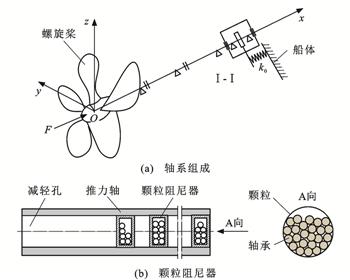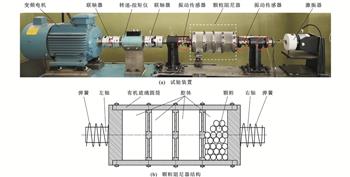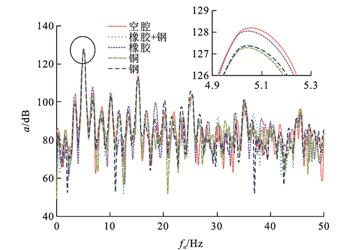| 颗粒阻尼抑制水下航行器轴系纵振模拟试验 |
| |
| 引用本文: | 杨俊, 刘正林, 刘杰, 王建, 程启超, 邓天扬. 颗粒阻尼抑制水下航行器轴系纵振模拟试验[J]. 交通运输工程学报, 2021, 21(5): 161-176. doi: 10.19818/j.cnki.1671-1637.2021.05.014 |
| |
| 作者姓名: | 杨俊 刘正林 刘杰 王建 程启超 邓天扬 |
| |
| 作者单位: | 1.武汉理工大学 能源与动力工程学院, 湖北 武汉 430063;;2.武汉第二船舶设计研究所, 湖北 武汉 430064 |
| |
| 基金项目: | 国家自然科学基金项目51379168工信部高技术船舶专项项目CJ02N20 |
| |
| 摘 要: | 
在简谐激励条件下,应用轴系颗粒阻尼纵振抑制模拟试验装置研究了旋转工况下的颗粒阻尼减振比;探讨了单腔体多颗粒和多腔体多颗粒时的轴系模拟系统加速度变化,讨论了颗粒的材料、粒径、质量填充比、腔体数量、转速、激励频率与位移等参数对系统减振比的影响规律。
研究结果表明:在单腔体多颗粒条件下,填充有铜、钢、橡胶包钢颗粒的系统减振比处于7.83%~8.91%,橡胶颗粒的系统减振比接近于0;铜、钢、橡胶包钢颗粒有明显的抑振效果,颗粒的材料密度和阻尼比越大,抑振效果越好;当颗粒质量填充比为15%时,系统减振比最高为13.77%,但当质量填充比超过15%时,减振比有所降低,故质量填充比一般应根据实际情况控制在15%左右;粒径、转速、激励频率与位移幅值的变化对系统减振比的影响分别为1.76%~8.68%、6.77%~12.50%、4.41%~10.12%与2.19%~7.05%;在多腔体多颗粒工况下,当颗粒总质量填充比和转速一定时,腔体数量对系统减振比有明显影响;当腔体数量为3时,转速为100 r·min-1和质量填充比为25%的最佳系统减振比为22.5%;在多腔体多粒径颗粒工况下,当总质量填充比为10%,转速为50~150 r·min-1的系统减振比波动不大,平均为14.18%,这表明多腔体多粒径组合对转速不十分敏感,具有较好的减振效果,可拓宽转速使用范围。

|
| 关 键 词: | 载运工具 纵振抑制 模拟试验 颗粒阻尼 减振比 质量填充比 腔体数量 |
| 收稿时间: | 2021-05-07 |
| 本文献已被 万方数据 等数据库收录! |
| 点击此处可从《交通运输工程学报》浏览原始摘要信息 |
|
点击此处可从《交通运输工程学报》下载免费的PDF全文 |
|



